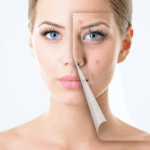Are skin tone variations, dark spots, or widespread blemishes discouraging you when you look in the mirror? You're not alone. Skin blemishes are one of the most common aesthetic problems faced by both women and men, directly impacting self-confidence. While countless products and recommendations are available on the market, blemishes can often be too complex and stubborn to be addressed with at-home methods. The key to success is accurately understanding the cause of the blemish and creating a personalized, professional treatment plan.
At my clinic, I use scientific and modern approaches to guide you on your journey to achieving smooth, bright, and even-toned skin. Let's explore the causes of skin blemishes and explore effective methods for getting rid of this annoying problem.
What is a Skin Spot and Why Does It Occur?
Melanin is the pigment that gives our skin its color. Melanin is a natural defense mechanism that protects our skin from the sun's harmful UV rays. However, in some cases, melanin-producing cells (melanocytes) become overstimulated, causing an excess of melanin to accumulate in certain areas of the skin. This localized darkening of skin tone is what we call "skin spots" or "hyperpigmentation."
The main factors that trigger stain formation are:
Effect of the Sun (Lentigo):
The primary culprit behind blemishes is the sun. Prolonged, unprotected sun exposure triggers the skin's defenses, leading to brown spots known as "sun spots" or "age spots," particularly on areas like the face, hands, and décolleté.
Hormonal Changes (Melasma):
This condition, particularly seen in women, can be triggered by pregnancy, birth control pill use, or hormonal treatments. It typically appears in a symmetrical, map-like pattern on the cheeks, forehead, and moustache area and is also known as the "pregnancy mask." It is one of the most difficult and highly specialized types of blemishes to treat.
After Skin Injuries (Post-Inflammatory Hyperpigmentation):
Inflammatory skin conditions like acne, eczema, or improper or aggressive treatments can leave brown or reddish scars behind after healing. This condition is called "post-inflammatory hyperpigmentation" (PIH) and occurs when the skin produces melanin as part of its self-healing process.
Genetic Predisposition:
Some people's skin may be genetically predisposed to blemishes, with freckles being a particularly prominent example.
Professional and Modern Methods for Stain Treatment
There's no "one size fits all" in treating spots; the most effective approach is a personalized protocol tailored to the type and depth of the spot, your skin type, and your lifestyle. At our clinic, we create a personalized roadmap for you, combining the most current and effective treatment options.
Chemical Peel:
It involves the controlled application of specialized acid solutions (glycolic acid, trichloroacetic acid, etc.) to the skin's surface, at concentrations appropriate for the depth of the blemish. This process exfoliates the blemished top layer of skin, revealing a fresher, blemish-free, and healthier layer of skin underneath. It also stimulates skin renewal and collagen production.
Enzyme Peeling (Blemish Masks):
Specialized protocols like Cosmelan and Dermamelan are particularly effective for stubborn spots like melasma. These treatments involve the application of powerful enzymatic masks that suppress melanin production in the clinic, followed by the patient supporting the process with specialized follow-up products at home. They aim to control spot formation both on the surface and in deeper layers.
Spot Mesotherapy:
It involves injecting a special blend of vitamins, antioxidants, amino acids, and hyaluronic acid, which have properties that lighten spots and suppress melanin production, directly into blemished areas of the skin using very fine needles. This method combats blemishes directly at their source, resulting in both lightening of the skin tone and improving the overall quality and radiance of the skin.
The Importance of Home Maintenance Products:
Remember, professional treatments are only part of the battle. A personalized home care routine is essential to ensure lasting results and prevent new spots from forming. Products with anti-spot ingredients like retinoids, vitamin C, azelaic acid, and niacinamide, and of course, sunscreen, are essential for this process.
The Spot Treatment Process with Dr. Filiz Gültekin: Patience and Proper Planning
Spot treatment is a marathon that requires patience and expert guidance. Rather than instantaneous, miraculous results, we aim for a step-by-step, lasting, and healthy recovery.
- Step 1: Skin Analysis and Correct Diagnosis: The process begins with a detailed skin analysis to determine the type, depth and cause of your blemish.
- Step 2: Personalized Treatment Protocol: Based on the analysis results, we decide which of the chemical peeling, mesotherapy or other methods or a combination of them is most suitable for you and plan the number and intervals of sessions.
- Step 3: Monitoring and Protection: We closely monitor your skin's response throughout the treatment and update the protocol as needed. Most importantly, we ensure you're practicing good sun protection habits to maintain your results.
The Golden Rule to Prevent Spot Formation: Sun Protection!
The cornerstone of all spot treatments and the most effective way to prevent spots from forming is to use broad-spectrum sunscreen (UVA/UVB protection) with at least SPF 30 every day, in every season, even on cloudy days. This habit not only ensures the success of your current treatment but also acts as your strongest shield against future spots and skin aging.
You don't have to deal with blemishes on your skin alone. With accurate diagnosis, effective treatment methods, and expert guidance, achieving brighter, smoother, and more even-toned skin is no longer a dream.
You can schedule a consultation at our clinic to listen to your skin's story and create a personalized spot treatment protocol.









